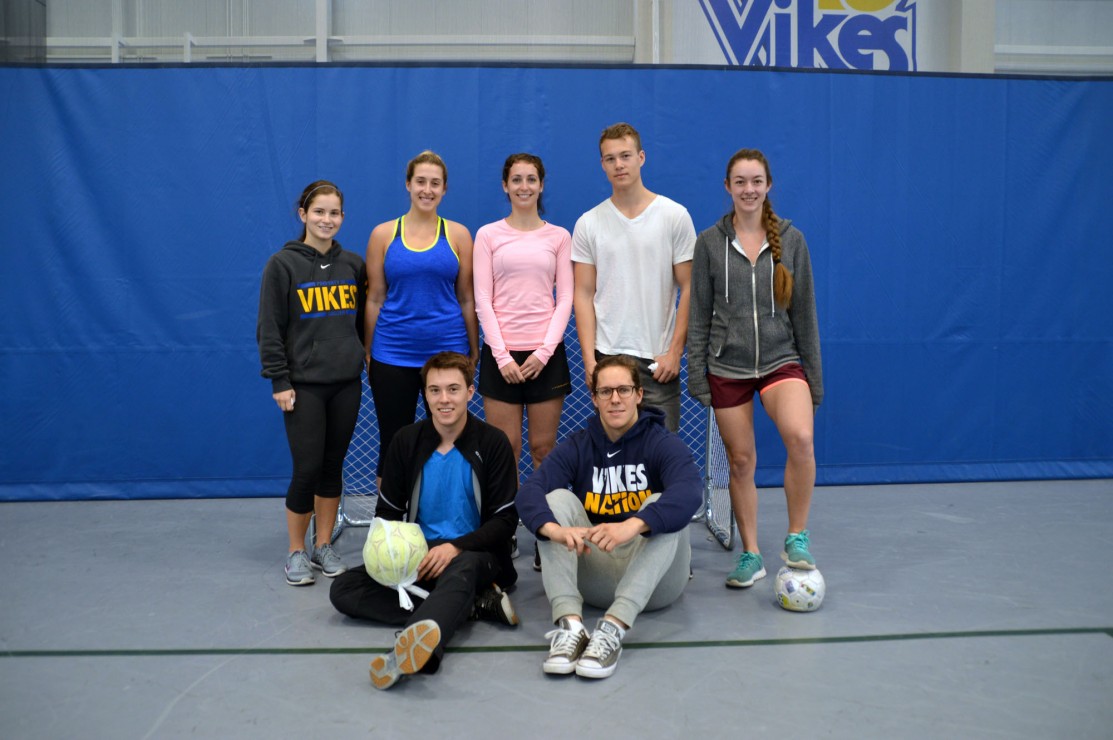
The Victoria Blind Football Club hangs out at their orientation day April 9. From left to right, top row: Terésa Anania, Emma Rigsby, Liam Webster, and Emilie Noble Bottom row: Lindsay Webster, Radek Wiechecki. Photo by Anna Wortberg
Some call it soccer, others call it football. No matter the name, soccer is played in over 200 countries and is the most watched sport in the world. At its most basic level, soccer only requires a ball and a single player to start—it’s one of the most accessible sports because of its language of motion and teamwork. And yet, there are still some who don’t get a chance to play the sport that brings over 265 million players together.
When UVic Kinesiology students Lindsay Webster and Radek Wiechecki first discovered that Canada couldn’t field a football 5-a-side team in the 2015 Pan Am games due to lack of participants, they took action to promote interest in the sport and provide opportunities for visually impaired individuals to get involved in physical activity. The result is the Victoria Blind Football Club (VFBC), B.C.’s first blind soccer league.
“Obviously there are some challenges involved,” said Wiechecki. “The idea is to have this inclusive community, [and] to have these opportunities.”
But how would a blind person know where to shoot or even where the ball is on the field? 5-a-side blind soccer is played indoor on a field surrounded by boards on all sides with a ball that rattles. On each end of the field and on each side, sighted teammates can tell the players where to shoot and where to move.
As not everyone has the same degree of blindness, all players wear blindfolds (except for a fully-sighted goalie) so that they are on the same place on the spectrum of blindness. This also means people who are fully sighted can try the game out.

Liam Webster (left) and Radek Wiechecki (back right) guide Emilie Noble at orientation. Photo by Anna Wortberg
With the help of CanAssist and Vikes Athletics, the VBFC put on a training day on April 9 for volunteers who will be assisting the new players at their first event in late May.
Alyssa Hindle from CanAssist has helped the VBFC make connections with the parasport community and with Vikes Athletic to get support for the new club that allows for both visually impaired and fully-sighted people to come together and experience something new.
“It will be a great way for people who maybe are hesitant about other [para]sports,” said Hindle. “It’s truly an inclusive opportunity . . . It levels the playing field.”
Fourth-year Kinesiology student and current VBFC volunteer Emilie Noble hopes her involvement creates the positive impact that sports has had on her life for others in the community. She says the most exciting aspect of volunteering is “the new experience and helping people that have never really had this opportunity before.”
The VBFC will host its first drop-in club game at CARSA on May 26 at 8 p.m., and will run drop-in games two times a month. Their ultimate goal is that popularity for the sport will build so that, one day, Canada will be able to field a team in the Pan Am Games.
“We want to make it fun and foster long term participation in the sport,” said Webster.
More information about game dates and times can be found on the Vikes Recreation drop-in schedule.








